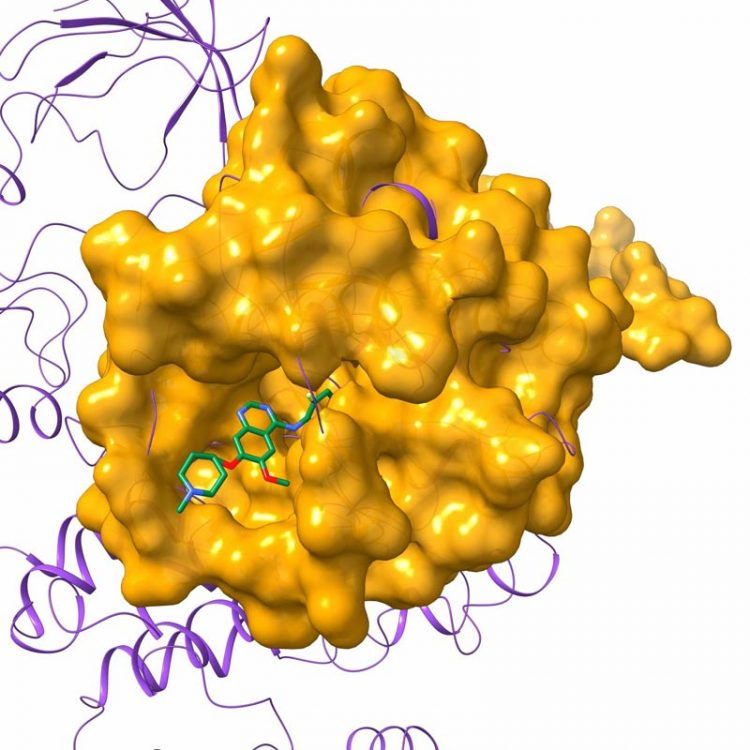Researchers computationally find the needle in a haystack to treat rare diseases

Chemotherapeutic vandetanib bound to its main target Protein Tyrosine Kinase 6 (PTK6) in purple, which is involved in many cancers including gastrointestinal tumors and ovarian cancers. By modeling vandetanib and PTK6 complex, researchers at LSU found that the KRAS protein to also contain a similar drug-binding site and therefore to be a good match for the same drug. The computer-generated model of KRAS in gold with vandetanib depicts the predicted interaction. Credit: Misagh Naderi, LSU
Researchers at the LSU Computational Systems Biology group have developed a sophisticated and systematic way to identify existing drugs that can be repositioned to treat a rare disease or condition. They have fine-tuned a computer-assisted drug repositioning process that can save time and money in helping these patients receive effective treatment.
“Rare diseases sometimes affect such a small population that discovering treatments would not be financially feasible unless through humanitarian and governmental incentives. These conditions that are sometimes left untreated are labeled 'orphan diseases.'
We developed a way to computationally find matches between rare disease protein structures and functions and existing drug interactions that can help treat patients with some of these orphan diseases,” said Misagh Naderi, one of the paper's lead authors and a doctoral candidate in the LSU Department of Biological Sciences.
This research will be published this week in the npj Systems Biology and Applications journal, published by the Nature Publishing Group in partnership the Systems Biology Institute.
“In the past, most repurposed drugs were discovered serendipitously. For example, the drug amantadine was first introduced to treat respiratory infections. However, a few years later, a patient with Parkinson's disease experienced a dramatic improvement of her disease symptoms while taking the drug to treat the flu. This observation sparked additional research.
Now, amantadine is approved by the Food Drug Administration as both an antiviral and an antiparkinsonian drug. But, we can not only rely on chance to find a treatment for an orphan disease,” said Dr. Michal Brylinski, the head of the Computational Systems Biology group at LSU.
To systematize drug repurposing, Naderi, co-author Rajiv Gandhi Govindaraj and colleagues combined eMatchSite, a software developed by the same group with virtual screening to match FDA approved drugs and proteins that are involved in rare diseases. LSU super computers allows them to test millions of possibilities that will cost billions of dollars to test in the lab.
###
This work was supported by the National Institute of General Medical Sciences of the National Institutes of Health [R35GM119524].
Media Contact
All latest news from the category: Life Sciences and Chemistry
Articles and reports from the Life Sciences and chemistry area deal with applied and basic research into modern biology, chemistry and human medicine.
Valuable information can be found on a range of life sciences fields including bacteriology, biochemistry, bionics, bioinformatics, biophysics, biotechnology, genetics, geobotany, human biology, marine biology, microbiology, molecular biology, cellular biology, zoology, bioinorganic chemistry, microchemistry and environmental chemistry.
Newest articles

This self-powered sensor could make MRIs more efficient
MRI scans are commonly used to diagnose a variety of conditions, anything from liver disease to brain tumors. But, as anyone who has been through one knows, patients must remain…

Glimpses of a volcanic world
New telescope images of Jupiter’s moon Io rival those from spacecraft. Astronomers have captured a volcanic event on Jupiter’s moon Io at a resolution never before achieved with Earth-based observations….

Rewritable, recyclable ‘smart skin’ monitors biological signals on demand
Skin can send certain health-related signals, such as dry skin feeling tighter to indicate the need for moisture. But what if skin could be smarter, capable of monitoring and sharing…





















